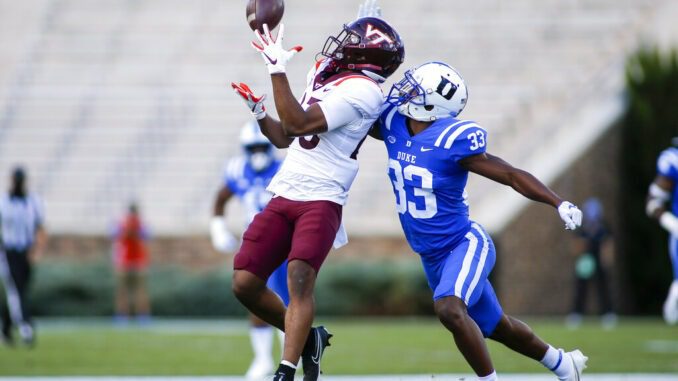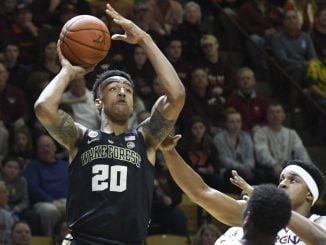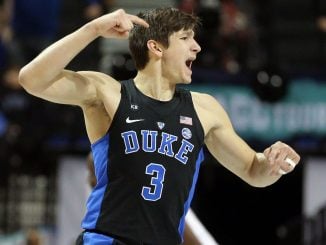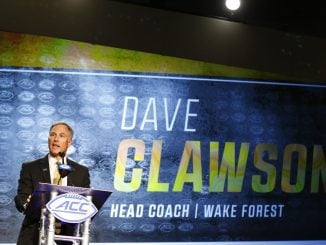
In Duke’s home opener against Boston College, David Cutcliffe came out of the locker room at halftime and was met by the television sideline reporter for the usual coach’s interview.
Glaring up at the empty stands at Wallace Wade Stadium, Cutcliffe put his hand to his ear and asked the reporter to repeat the question because he couldn’t hear it over the noise.
A few miles away and a week earlier when North Carolina held its home opener, quarterback Sam Howell avoided the pass rush on third down and lofted a pass to Dyami Brown 22 yards downfield. The P.A. announcer responded with the traditional call-and-response at Kenan Stadium.
“First down, Tar …,” he said.
“Heels!” came back a hearty shout from the crowd that was not there.
Meanwhile, in Carter-Finley Stadium, quarterback Bailey Hockman threw a pass deep downfield toward the sideline. As the ball flew through the air, a murmur of excitement grew steadily louder. Emeka Emezie was there, but the ball was batted away at the last minute, perhaps with some early contact.
A groan of disappointment, and perhaps outrage that there was no flag for pass interference, echoed through the empty stadium.
Welcome to pandemic football.
While fans are slowly beginning to trickle back into stadiums across the state, gameday operations staffs for North Carolina’s college football teams have been coping with the problem of making stadiums emptied by the coronavirus seem full. Cardboard cutouts can give the impression that sections are stuffed with fans, but they still needed a roar of the crowd.
Here’s a look at how the ACC, specifically the four North Carolina teams in the league, have tackled the problem of bringing the noise to empty stadiums across the state.
The murmur
Before there can be a roar of the crowd, there needs to be a murmur — a continuous, low-level, background murmur.
To give the auditory illusion of a full stadium, the ACC passed a policy requiring teams without fans in the stands to play ambient crowd noise on a continuous loop throughout the game. If small numbers of fans are allowed in, teams have the option of continuing the murmur, but it’s up to them.
According to the official ACC policy that was passed earlier this year, “The home team shall set the volume of continuous artificial ambient crowd noise, with the minimum decibel level being 70 decibels and the maximum decibel level being 85 decibels as measured at midfield.”
While human fans can raise their volume in an attempt to disrupt opposing offenses, that’s not allowed with the fake noise. It must remain at a consistent volume regardless of who has the ball or what’s going on in the game. Otherwise, the referees could throw a flag on the home team for either unsportsmanlike conduct or delay of game.
The last time teams played in front of full houses, they didn’t know they were going to need a continuous recording of crowd murmur. To help teams out, the ACC has provided various soundtracks.
“The league provided each school with two ambient crowd noise files,” said league representative Kevin Best, “one from EA Sports and one from the NFL. Schools can use either one.”
Most schools opted for the video game noise.
“It’s the Madden soundtrack,” Wake Forest Associate AD for Fan Engagement Rhett Hobart said. “We reached out to EA Sports when we thought we were going to be able to do this to work on getting some actual crowd noise. So we actually got that and shared it with the other schools so they could use it, too.”
Teams have implemented the background noise in various ways. Duke chooses to just let it play and forget about it. “Once we start the audio track, it is just loops through for the entire game,” said Chris Alston, Duke’s executive director of marketing.
Wake gives itself more flexibility.
“There’s three kinds of crowd beds, your basic underlying sound effect that plays the whole game,” Hobart said. “They’re low, medium and high excitement levels. We usually leave it at medium the whole game, but at moments, we may dial it down or up as needed. It doesn’t change the volume, just the tone of the crowd.”
Reactions
Then there’s the add-ons: Cheers for big plays, groans for disappointing ones.
“We are essentially having two different computers throughout the game,” Hobart said. “We are running a computer that has the regular music we use throughout the game, and we’re running a second computer that is solely dedicated to crowd noise. In addition to the dedicated track, we’re actually adding in crowd noise on top of that that indicates anticipation, celebration, those kinds of moments.”
Wake uses about 30 different reaction sounds that it pulled from EA Sports.
“If there’s a great pass downfield, we’re going to click the anticipation sound effect,” Hobart said. “Then we might play the celebration sound effect, so people are cheering when they actually score a touchdown.”
That leads to a bit of a gray area in ACC policy. Can the add-on sound effects be used while the play is going on?
Long passes seem to be one of the few plays where it would be possible to use an effect mid-play, and the camps are split on whether that’s allowed.
The policy says that the ambient noise “must comply with all ACC and NCAA Football Playing Rules to not create noise that prohibits a team from hearing its signals once the offensive team breaks its huddle or, if no-huddle, when the center addresses the ball, until the official whistles the play dead.”
Hard-liners take that to mean that nothing can be changed until the whistle.
“We are able to play crowd roars once a play is complete and the whistle has blown, but not while the play is still going on (ie. during an interception return),” says Duke’s Alston.
The ACC’s Best agrees.
“Teams can add their own reactions/cheers after the play is blown dead,” he says.
Still, the letter of the policy only refers to a change in the ambient noise and add-ons that are used to keep a team “from hearing its signals.” An anticipation sound effect while the ball is in the air would seem to be exempt, and some teams are reading the rule that way. So far, no flags have flown as a result.
Gameday environment
Other than the minor controversy over the mid-play reactions, the fake noise appears to be well-received by everyone, even if they all long for the day when it’s no longer required. Most teams intend to keep using it, even as they’re allowed to let in a few thousand fans.
After playing in front of 2,000 fans — 7% of Truist Field capacity, as allowed by state policy — Wake Forest return man Donavon Greene still heard the EA Sports sounds.
“They still had it pumpin’ back there,” he said.
Until the stands are full, it will have to serve as the best proxy teams have. And it seems to be a fairly good one.
“During the Clemson game a few weeks back, I actually got a number of texts from people watching around the country asking if we had fans at the game because, on TV, it sounded like it,” Hobart said.



